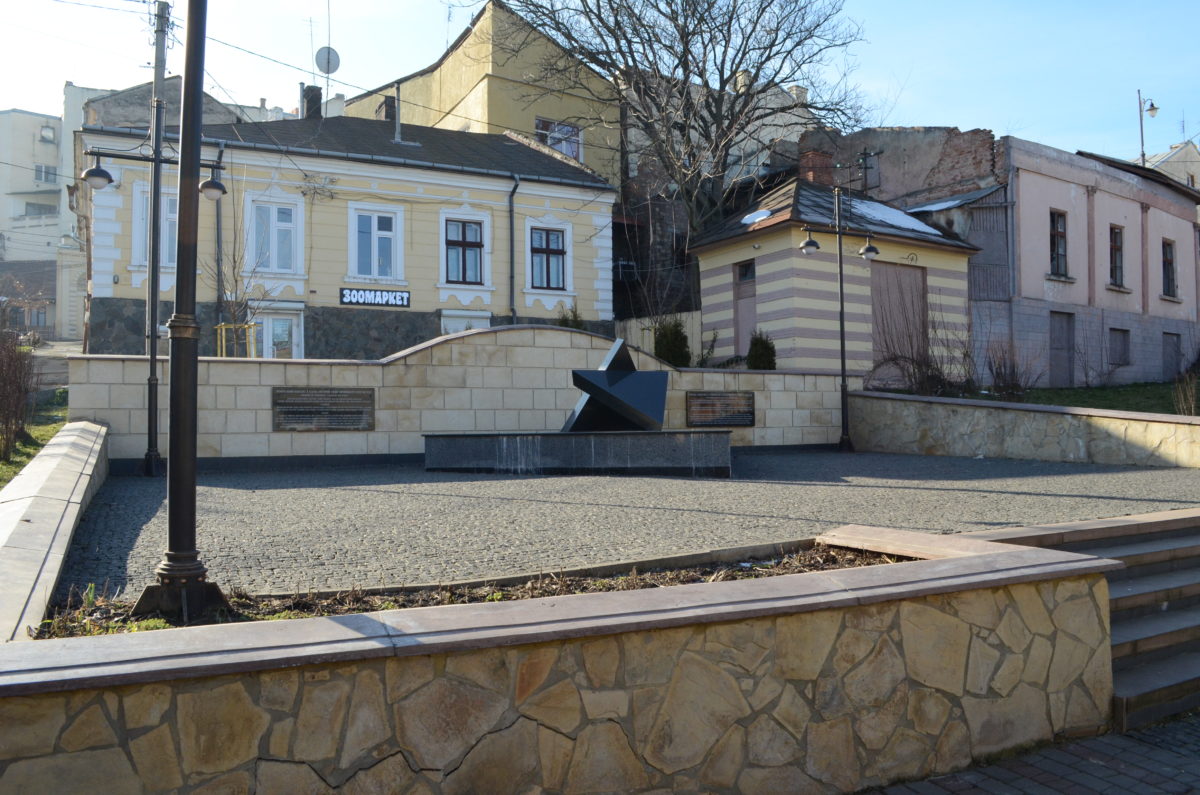At the corner of Shalom Aleichem and Petro Sahaidachnui Street, you will notice a memorial shaped like a broken “Star of David”. Initiated by Jewish organizations, this memorial was erected in 2016 close to the site of the main gate of the former Chernivtsi ghetto from 1941. It commemorates the Chernivtsi Ghetto and the genocide against local Jews during World War II.
In his interview with Centropa, Bruno Bittmann, born in 1928, shares his memories of life in the Chernivtsi ghetto:
On July 5, 1941, German troops occupied Chernivtsi. All Jews from Chernivtsi had to go to the ghetto. The ghetto consisted of a few streets that were cordoned off. Before the ghetto was established, she always took me to buy groceries in a small store, and helped the owner, a widow with three or four children. This woman’s apartment was now right in the ghetto and we were allowed to live with her. We were eight or nine people in a small basement apartment, but others were worse off.
We were only allowed on the streets at certain times. We had to wear a yellow star and boys like me attached the yellow star to a string and pulled it up or down when needed. That´s how we could go to the cinema. I remember that during Passover, when you have to drink kosher wine and eat mazzot, my father got handmade mazze from somewhere. My father made the wine himself from raisins. There was a lot of improvisation when we lived under the rule of the Germans, but we didn’t go hungry.
According to the order of the Romanian authorities on the 11th of October 1941 tens of thousands Chernivtsi Jews were forcibly resettled into the Chernivtsi Jewish ghetto. From here, the Jews were about to be deported. Initially, around 50.000 Jews were forced to live in the ghetto crammed together under disastrous conditions.
Sylvia Segenreich, born in 1926, shared in her Centropa interview what she remembers from living in the ghetto:
The ghetto was put up in autumn 1941. By chance, my father’s factory was there, and my grandmother lived there. That’s where we stayed. We lived with 30 family members in a three-room apartment. That was with my mother’s siblings and their families. Jews weren’t allowed to go out during the day or in the evening. Only from 10am to 1pm in order to buy things. But otherwise we weren’t allowed out on the streets.
Dora Nisman was born in 1912. Her family, too, was forced to move to the ghetto:
Announcements were put on buildings, ordering Jews to move to streets that were specifically marked for their residence. We started moving our belongings, but a German soldier told us to leave everything behind. He said that we were only going to stay in the ghetto temporarily. The streets were enclosed with wooden fencing. All dwellings were overcrowded. We lived in a laundry room and slept on the floor. I felt very ill, and as we didn’t have enough food, we exchanged everything we had managed to take with us for food. On December 25, 1941 my daughter was born. My sister and my father had to go ask a doctor to come at night because I was afraid the Germans would kill me in the hospital. We were aware that every day might be the last day of our lives. Some of our neighbors vanished every night.
The Romanian military administration guarded the ghetto, which was surrounded by a wooden fence. It was put up in a part of town where many Jews had already lived prior to the ghetto; this is where several Jewish institutions were located, such as the Jewish hospital, and the ghetto was also close the railway station, which played an important role for the deportation to Transnistria.
Carol Margulies shares in his Centropa interview how he and his family were deported and survived the camp:
In 1941, we were in the Chernivtsi ghetto and were forced to wear the yellow star. We weren’t allowed to go to the marketplace before 10 or 11am. Many Jews got beaten up in the middle of the street. (…) One Friday morning, soldiers came and told us, ‘You have 40 minutes to leave the house. Nobody is allowed to take more luggage than they can carry!’ They confiscated everything we took with us anyway. I’m not talking about wedding rings and other pieces of jewelry: this goes without saying. But they even took our papers. ‘You won’t need papers where you’re going!’ They took us to the train station. A day later, our entire family left for Bessarabia. We traveled in a cattle car, next to four other families. The soldiers made sure no one escaped.
The number of ghetto inhabitants was gradually reduced, as more than 28,000 Jews were deported within a few weeks to the hell that awaited them in the Transnistrian camps and ghettos. Around 16,000 Jews, however, got a special permission to stay in the town, as they were needed as workforce. Some Jews managed to stay in hiding or bribed Romanian officials. In late November 1941 the Chernivtsi ghetto was liquidated.
The Jewish ghetto is a tragic chapter in Chernivtsi’s history. The monument is a tribute to its victims, and a warning to future generations.
